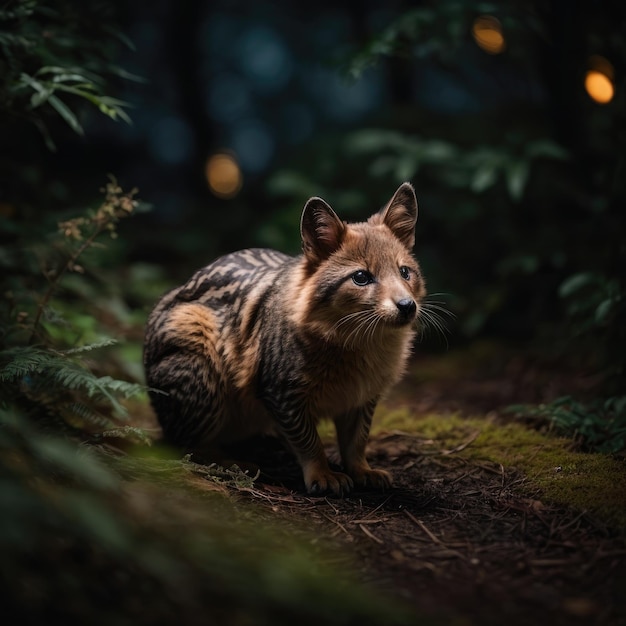Night Hunter: A Comprehensive Guide To Nocturnal Wildlife

Table of Contents
Adaptations of Nocturnal Animals
Nocturnal animals, or those primarily active at night, possess incredible adaptations allowing them to thrive in low-light conditions. These adaptations can be broadly categorized as sensory and behavioral.
Sensory Adaptations
Many nocturnal animals boast heightened senses to navigate and hunt in the dark.
-
Exceptional Night Vision: Animals like owls and cats possess exceptional night vision thanks to:
- Larger pupils: Allowing more light to enter the eye.
- Tapetum lucidum: A reflective layer behind the retina that amplifies light sensitivity.
- High concentration of rod cells: Rod cells in the retina are responsible for vision in low light. Owls, for example, have an incredibly high concentration of these cells.
-
Superior Hearing: Bats and owls are prime examples of animals with superb hearing. Bats use echolocation – emitting high-frequency sounds and interpreting the echoes to navigate and locate prey. Owls possess asymmetrical ear openings, which help them pinpoint the exact location of sounds with incredible precision.
-
Keen Sense of Smell: Many nocturnal mammals rely heavily on their sense of smell. Skunks, for example, use their powerful scent for defense and communication, while rodents utilize their sensitive noses to find food and avoid predators. Nocturnal animals often have larger olfactory bulbs in their brains compared to diurnal animals, further enhancing this sense.
Behavioral Adaptations
Beyond enhanced senses, nocturnal animals have developed specific behaviors to survive at night.
-
Nocturnal Hunting Strategies: Nocturnal animals employ various hunting techniques. Ambush predators, like many owls and cats, patiently wait for prey to come within striking distance. Active foragers, such as bats and some rodents, actively search for food throughout the night.
-
Nocturnal Social Behaviors: Social structures and communication vary amongst nocturnal animals. Some species, like African hunting dogs, engage in coordinated group hunts at night. Others rely on vocalizations, scent marking, or other forms of communication to maintain social bonds and territory.
-
Predator Avoidance: Nocturnal animals use various strategies to avoid predators. Camouflage, such as the mottled fur of many nocturnal mammals, helps them blend into their surroundings. Their nocturnal activity itself acts as a form of predator avoidance, as many predators are diurnal.
Common Nocturnal Animals and Their Habitats
Nocturnal animals occupy diverse habitats across the globe, each exhibiting unique adaptations suited to their environment.
Forest Nocturnal Wildlife
Forests and woodlands teem with nocturnal life:
- Owls: Different owl species inhabit various forest types, preying on rodents, insects, and other small animals. Their silent flight and exceptional hearing are crucial for successful hunting.
- Foxes: Red foxes and other fox species are skilled nocturnal hunters, thriving in forests and adapting to various habitats.
- Bats: Numerous bat species inhabit forests, playing vital roles as pollinators and insectivores. Their echolocation allows them to navigate and hunt insects in the dark.
- Raccoons: Highly adaptable omnivores, raccoons are active at night, foraging for food in forests and urban areas alike.
- Possums: These marsupials are slow-moving but remarkably successful nocturnal foragers, consuming insects, fruits, and other food sources.
Desert Nocturnal Wildlife
Desert environments present unique challenges, demanding specialized adaptations from nocturnal animals:
- Desert Foxes: Fennec foxes and other desert fox species have large ears to dissipate heat and specialized kidneys for efficient water conservation.
- Owls: Certain owl species are adapted to the harsh desert conditions, their nocturnal hunting allowing them to avoid the extreme daytime heat.
- Kangaroo Rats: These rodents have extremely efficient kidneys, extracting water from their food and minimizing water loss through their urine.
- Scorpions: Nocturnal hunters, scorpions utilize their venomous stingers to subdue prey in the desert night.
Marine Nocturnal Wildlife
The ocean's depths also harbor a wealth of nocturnal animals:
- Squid: Many squid species are nocturnal, using bioluminescence for communication and hunting.
- Certain Fish Species: Numerous fish species exhibit nocturnal behavior, adapting their hunting and feeding strategies to the darkness of the ocean.
- Sea Turtles: Some sea turtle species forage for food at night, navigating using the Earth's magnetic field.
Threats to Nocturnal Wildlife
Nocturnal animals face a multitude of threats in today's world.
Habitat Loss and Fragmentation
Deforestation, urbanization, and agricultural expansion lead to habitat loss and fragmentation, severely impacting nocturnal animal populations.
- Specific Examples: The clearing of forests for logging and agriculture destroys the habitats of owls, bats, and other forest-dwelling nocturnal animals. Urban sprawl fragments habitats, isolating populations and reducing genetic diversity.
Light Pollution
Artificial light at night disrupts the natural rhythms and behaviors of nocturnal animals.
- Negative Effects: Light pollution can interfere with navigation, hunting, and mating behaviors. It can also attract predators or make prey more vulnerable. Studies show a decline in insect populations due to artificial light, impacting bats and other insectivorous animals.
Climate Change
Climate change poses a significant threat to nocturnal animals, altering their habitats and distributions.
- Climate Change Impacts: Changes in temperature and precipitation patterns can affect the availability of food and water, impacting migration patterns and potentially leading to range shifts or population declines.
Conclusion
This guide has explored the fascinating world of nocturnal wildlife, highlighting their remarkable adaptations, diverse habitats, and the threats they face. Understanding the challenges these “night hunters” encounter is crucial for their conservation. By appreciating the beauty and complexity of nocturnal ecosystems, we can work together to protect these incredible creatures and ensure their survival for generations to come. Learn more about specific nocturnal wildlife in your area and support organizations dedicated to their conservation. Continue your exploration of the captivating world of Nocturnal Wildlife!

Featured Posts
-
 Royal Honors Row Pvv Ministers Stand On Asylum Volunteers
May 11, 2025
Royal Honors Row Pvv Ministers Stand On Asylum Volunteers
May 11, 2025 -
 Your Senior Year A Detailed Calendar Of Trips And Events
May 11, 2025
Your Senior Year A Detailed Calendar Of Trips And Events
May 11, 2025 -
 Magic Performance Leads Celtics To Division Title
May 11, 2025
Magic Performance Leads Celtics To Division Title
May 11, 2025 -
 Doze D Economie Realiser Des Economies Concretes
May 11, 2025
Doze D Economie Realiser Des Economies Concretes
May 11, 2025 -
 Critical Condition Update On Prince Andrew Accuser Following Crash
May 11, 2025
Critical Condition Update On Prince Andrew Accuser Following Crash
May 11, 2025
